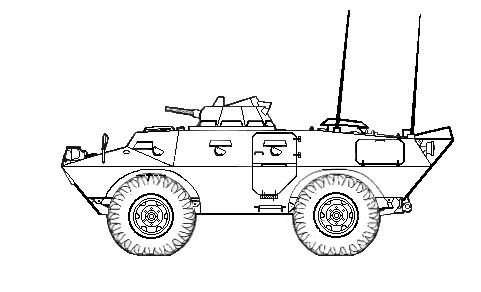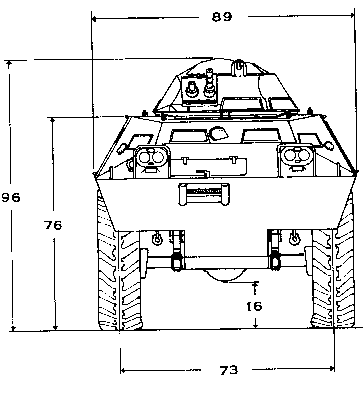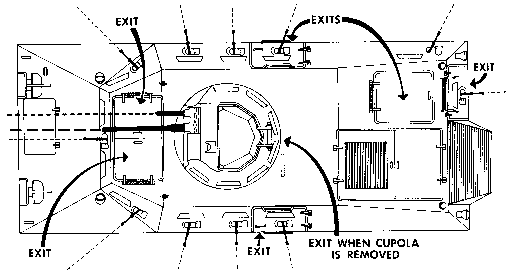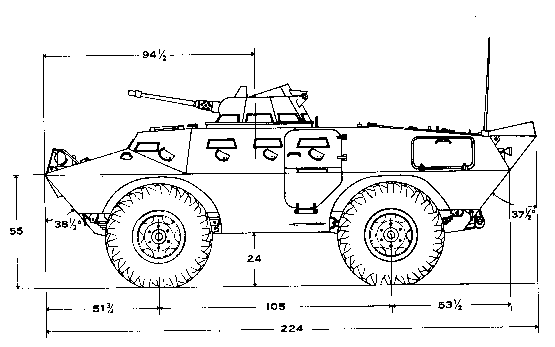

Cadillac Gage V-100 "Commando"
The V-100, designated the M-706, was designed using existing inventory parts to ease manufacture, logistics, and simplify repair. The engine was a stock Chrysler 361 cu in. gasoline automobile engine. The axles and transmission components were from military heavy truck components. The armor was about .50 inch ballistic plate steel, capable of stopping small arms and shell fragments. The tires were "run flat" capable of going about 30 miles on the sidewalls alone if the tires were punctured.
|
USAF Model w/ Accordion Hatch open and folded to sides |
 |
|
![]()

This is a diagram of one of the common Army variants with twin .30 machineguns in a cupola. The U.S. Army Military Police used the M-706 for base defense and for road security on convoy escorts.
![]()

Front view of variant with one .50 and one .30 caliber machinegun. Standard US military day and infrared headlamp assemblies are visible, as is the access hatch and roller lined opening for the winch. From the USAF Security Police Combat Preparedness School Course Manual, circa 1971.
![]()

Top view same configuration as above and same source. This shows the extra gun port on the sides of some models. There are two roof hatches on the hull below the gun barrels that swung up and to the side for the driver and "co-driver". Another roof hatch on the rear right that swings up; the cupola hatch; and the rear door hatch, which was two parts one swinging down, the top swinging up. The two part hatch on the rear left of the hull roof is engine/radiator access. The small door on the front between the headlights is for access to the winch. Dual fuel fillers are on the glacis plate near the 45 degree vision ports.
![]()

Side view same .50/.30 caliber configuration, same source document, also showing the extra gun port and vision block on the hull sides forward of the side doors on some models. The side doors had two halves, one half swings to the rear, and the lower half swings down. The small rectangular hatch on the upper right of this hull is an access door to the engine compartment.
![]()
Problems.......
One of the weaknesses of the V-100 design was the fact that it weighed almost 7 tons unloaded. Once loaded with people, weapons, ammo and equipment this quickly exceeded the rated capacity of the drive line. Broken axles were probably the most common mechanical failure area, and were later beefed up in the V-150.
The other problem was that the V-100 was gasoline powered, and had two 40 gallon gas tanks one on the inside of each front wheel well. Needless to say an RPG hit there could ruin your day. In the V-150/V-200 series the gasoline engines were replaced by diesels. You would have thought that the US military would have learned that lesson from WW-2 where our gasoline powered tanks and armored cars exploded violently on being hit; while German tanks, with diesel engines, merely caught fire.
![]()
The last of the M-706's in use by the USAF were during the mid to late 1970's when many were assigned to stateside airbases for use by USAF Security Forces in their role of protecting nuclear storage sites. 4500 Security Police at Langley AFB, in Virginia, received two of them in early 1975. Other bases were assigned M-113's, Nellis AFB in Nevada was one.
To the best of my knowledge all these have been retired since then and replaced with the "Peacemaker" vehicle, which is essentially a lightly armored box on a light truck chassis: Not exactly a real "fighting vehicle" either in looks or in reality.
![]()
Some police agencies acquired or bought V-100's including New Orleans, which obtained one of the accordion topped USAF variants, under an Law Enforcement Assistance Agency (LEAA) grant back in the 1970's. The media quickly lambasted them for buying "a tank" and the V-100 is nothing of the sort: it was and is a light armored personnel carrier. Frankly, given the rash of shootouts facing police in the late 1980's and 1990's the New Orleans decision seems rather intelligent.
In reality the V-100 makes a good police emergency vehicle for particular operations: handy to extract officers or citizens (wounded or not) under fire, or approaching barricaded suspects. Needless to say one might have come in useful during the L.A. shootout with the two heavily armed bank robbers last year.
I have learned that L.A.P.D. has at least two of these vehicles, but for the North Hollywood incident the response time from their parking area was too great and the incident was "ended" before they could arrive. I have also seen tapes of the LA Riots over the King verdict, and in one of them an L.A.P.D. V-100, with attached "SWAT" team, is filmed trying to locate a sniper shooting at fire equipment responding to the fires set by rioters.
![]()
The V-100's successor, the LAV-150, is still in production by the Marine and Land Systems Division of Textron, which acquired Cadillac Gage, and is in wide use as an internal security, police, and base defense force vehicle by many nations.
Some were used by the Saudi's at the battle of Kafjhi, Saudi Arabia, during Desert Storm, where they suffered commensurately heavy losses when taking on Iraqi main battle tanks. Someone should have reminded the Saudi's that while the V-100/150 variants are great vehicles within their design limits, you do NOT take a knife to a gun fight.
The V-150 has gone out of production and Textron is now producing the M1117 ASV (Armored Security Vehicle) for the US army. This is an updated design with improved armor and features. The basic vehicle on their site includes a turreted weapon, along with several other configurations. The Command and Control version could have applications as a police APC for homeland defense, barricaded suspect and officer under fire rescues.
![]()
LINKS TO OTHER V-100/XM-706 RELATED SITES |
||||||
|---|---|---|---|---|---|---|
|